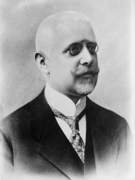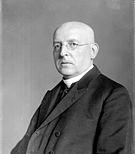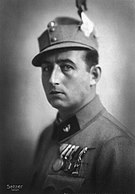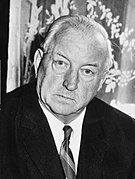The chancellor of Austria is the head of government of Austria , appointed by the president and viewed as the country's de facto Cabinet , which also includes the vice-chancellor and the ministers .[ 2]
Following World War I , the office was established by the Provisional National Assembly on 30 October 1918 and named state chancellor of the Republic of German-Austria , and its first holder, Karl Renner , was appointed by the State Council . After the Allied powers forbade German-Austria to merge with the Weimar Republic ,[ 3] First Austrian Republic and the office was renamed from state chancellor to federal chancellor. The first federal chancellor was Michael Mayr . Ten chancellors served under the First Republic until Chancellor Engelbert Dollfuss created the authoritarian and dictatorial Federal State of Austria .[ 4] Dollfuss's assassination by Austrian National Socialists ,[ 5] Kurt Schuschnigg succeeded him as chancellor and upheld the dictatorship.[ 6] Arthur Seyss-Inquart , a Nazi caretaker who held the office for two days, until Austria was annexed into Nazi Germany .[ 7]
Austria under National Socialism lost its original republican system of government and was administered by Reichsstatthalter Reichskommissar Josef Bürckel [ 8] Reichsstatthalter Baldur von Schirach [ 9] Ostmark , completely lost its autonomy, and became a sub-national division of Nazi Germany .[ 10] [ 11] liberation of Vienna and the capitulation of Nazi Germany in 1945, Austria restored its republican form of government.[ 12] Austria remained under allied occupation until 1955[ 13] Allied Control Council .
Since the institution of the republic, the People's Party and the Social Democratic Party have largely dominated Austrian politics; the People's Party (and its predecessor, the Christian Social Party ) have led nineteen cabinets and served as a junior partner in eight, while the Social Democratic Party (formerly the Social Democratic Workers' Party) has led eleven and served as a junior partner in five. There have been seven parties that never held the chancellorship but participated in coalition cabinets: the Greater German People's Party in five, the Freedom Party and the Landbund in four, the Fatherland Front in two, and the Greens , the Alliance for the Future , and the Communist Party in one.
Following a legislative election or in the case of a vacancy, the president conventionally picks the leader of the largest party in Parliament to serve as chancellor, and appoints the remaining members of the Cabinet based on the chancellor's recommendation. If a sitting chancellor dies, resigns, or is otherwise unable to exercise the powers and duties of the office, the vice-chancellor becomes acting chancellor. If the vice-chancellor is unavailable, the other members of the Cabinet take over in order of seniority.[ 14]
Bruno Kreisky was the longest-serving chancellor, with more than thirteen years in office, while Arthur Seyss-Inquart was the shortest-serving chancellor, with two days in office, and Walter Breisky was the shortest-serving acting chancellor, with only one day in office.
Chancellors
‡
Key to historical parties
1922–1934: Rural Federation /
Landbund (LBd)
No.
Portrait
Name(born–died)
Term of office
Party
Elected
Cabinetcoalition
Ref.
Took office
Left office
Time in office
1
Karl Renner [ a] [ b] (1870–1950)
30 October 1918
7 July 1920
SDAPÖ
1919
Renner I –II –III • SDAPÖ • CS • GDVP
[ 15] [ 16] [ 17]
2
Michael Mayr [ c] (1864–1922)
7 July 1920
21 June 1921
CS
1920
Mayr I –II • CS • SDAPÖ
[ 18]
3
Johannes Schober (1874–1932)
21 June 1921
26 January 1922
IND
–
Schober I • • • [ 19]
–
Walter Breisky (1871–1944) 26 January 1922
27 January 1922
CS
–
Breisky • • [ 20]
(3)
Johannes Schober (1874–1932)
27 January 1922
31 May 1922
IND
–
Schober II • CS • GDVP • Technocrats
[ 21]
4
Ignaz Seipel (1876–1932)
31 May 1922
20 November 1924
CS
1923
Seipel I –II –III • CS • GDVP • Technocrats
[ 22]
5
Rudolf Ramek (1881–1941)
20 November 1924
20 October 1926
CS
–
Ramek I –II • CS • GDVP
[ 23]
(4)
Ignaz Seipel (1876–1932)
20 October 1926
4 May 1929
CS
1927
Seipel IV –V • CS • GDVP • LBd
[citation needed
6
Ernst Streeruwitz (1874–1952)
4 May 1929
26 September 1929
CS
–
Streeruwitz • • [ 24]
(3)
Johannes Schober (1874–1932)
26 September 1929
30 September 1930
IND
–
Schober III • CS
[citation needed
7
Carl Vaugoin (1873–1949)
30 September 1930
4 December 1930
CS
–
Vaugoin • CS
[ 25]
8
Otto Ender (1875–1960)
4 December 1930
20 June 1931
CS
1930
Ender • CS
[ 26]
9
Karl Buresch (1878–1936)
20 June 1931
20 May 1932
CS
–
Buresch I –II • CS • LBd
[ 27]
10
Engelbert Dollfuss (1892–1934)
20 May 1932
25 July 1934 †
CS
–
Dollfuss I • CS • LBd • Heimwehr 20 May 1932 – 1 May 1934 Dollfuss II • VF 1 May 1934 – 25 July 1934
[ 28]
VF
–
PrinceErnst Rüdiger Starhemberg (1899–1956)
25 July 1934
29 July 1934
VF
–
Dollfuss II • VF
[ 29]
11
Kurt Schuschnigg (1897–1977)
29 July 1934
11 March 1938
VF
–
Schuschnigg I –II –III –IV –V • VF
[ 30]
12
Arthur Seyss-Inquart (1892–1946)
11 March 1938
13 March 1938
NSDAP
–
Seyss-Inquart • NSDAP
[ 31] [ 32]
Austria was part of Nazi Germany from 13 March 1938 to 27 April 1945
(1)
Karl Renner [ d] (1870–1950)
27 April 1945
20 December 1945
SPÖ
–
Renner IV • SPÖ • ÖVP • KPÖ
[ 33] [ 34] [ 35]
13
Leopold Figl (1902–1965)
20 December 1945
2 April 1953
ÖVP
1945
Figl I –II –III • ÖVP • SPÖ
[ 36]
1949
14
Julius Raab (1891–1964)
2 April 1953
11 April 1961
ÖVP
1953
Raab I –II –III –IV • ÖVP • SPÖ
[ 37]
1956
1959
15
Alfons Gorbach (1898–1972)
11 April 1961
2 April 1964
ÖVP
1962
Gorbach I –II • ÖVP • SPÖ
[ 38]
16
Josef Klaus (1910–2001)
2 April 1964
21 April 1970
ÖVP
–
Klaus I • ÖVP • SPÖ
[ 39]
1966
Klaus II • ÖVP
17
Bruno Kreisky (1911–1990)
21 April 1970
24 May 1983
SPÖ
1970
Kreisky I –II –III –IV • SPÖ
[ 40]
1971
1975
1979
18
Fred Sinowatz (1929–2008)
24 May 1983
16 June 1986
SPÖ
1983
Sinowatz • SPÖ • FPÖ
[ 41]
19
Franz Vranitzky (born 1937)
16 June 1986
28 January 1997
SPÖ
1986
Vranitzky I –II • SPÖ • FPÖ
[ 42]
1990
Vranitzky III –IV –V • SPÖ • ÖVP
1994
1995
20
Viktor Klima (born 1947)
28 January 1997
4 February 2000
SPÖ
–
Klima • SPÖ • ÖVP
[ 43]
21
Wolfgang Schüssel (born 1945)
4 February 2000
11 January 2007
ÖVP
1999
Schüssel I • • 4 February 2000 – 3 April 2005 Schüssel II • • 3 April 2005 – 11 January 2007
[ 44]
2002
22
Alfred Gusenbauer (born 1960)
11 January 2007
2 December 2008
SPÖ
2006
Gusenbauer • • [ 45]
23
Werner Faymann (born 1960)
2 December 2008
9 May 2016
SPÖ
2008
Faymann I –II • • [ 46]
2013
–
Reinhold Mitterlehner (born 1955) 9 May 2016
17 May 2016
ÖVP
–
Faymann II • • [ 47] [ 48]
24
Christian Kern (born 1966)
17 May 2016
18 December 2017
SPÖ
–
Kern • • [ 49]
25
Sebastian Kurz (born 1986)
18 December 2017
28 May 2019
ÖVP
2017
Kurz I • • 18 December 2017 – 22 May 2019 • [ 50]
–
Hartwig Löger (born 1965) 28 May 2019
3 June 2019
ÖVP
–
Kurz I • ÖVP
[ 51] [ 52]
26
Brigitte Bierlein (1949–2024)
3 June 2019
7 January 2020
IND
–
Bierlein • Technocrats
[ 53] [ 54]
(25)
Sebastian Kurz (born 1986)
7 January 2020
11 October 2021
ÖVP
2019
Kurz II • ÖVP • Greens
[ 55]
27
Alexander Schallenberg (born 1969)
11 October 2021
6 December 2021
ÖVP
–
Schallenberg • ÖVP • Greens
[ 56]
28
Karl Nehammer (born 1972)
6 December 2021
10 January 2025
ÖVP
–
Nehammer • ÖVP • Greens
[ 57]
–
Alexander Schallenberg (born 1969) 10 January 2025
Incumbent
ÖVP
–
Nehammer • ÖVP • Greens
[ 58]
Timeline
See also
Notes
References
External links
Leadership Österreichischer Bundesadler Ministries
Current:
Arts, Culture, the Civil Service and Sport Chancellery Defence Digital and Economic Affairs Education, Science and Research Finance European and International Affairs Interior Justice Social Affairs, Health, Care and Consumer Protection Agriculture, Regions and Tourism Climate Action, Environment, Energy, Mobility, Innovation and Technology Labour Historical:
Ministers










































